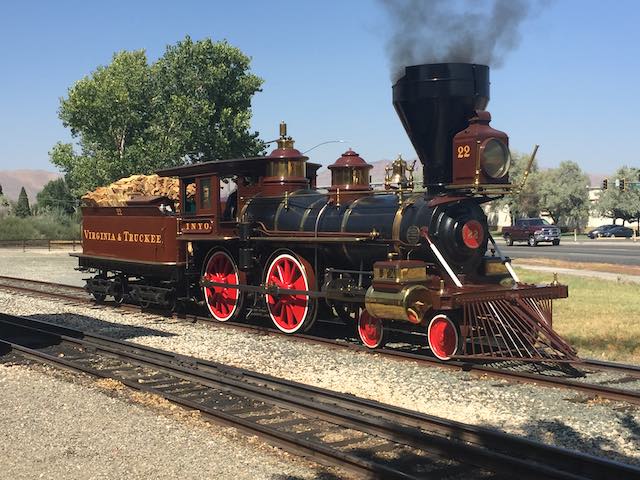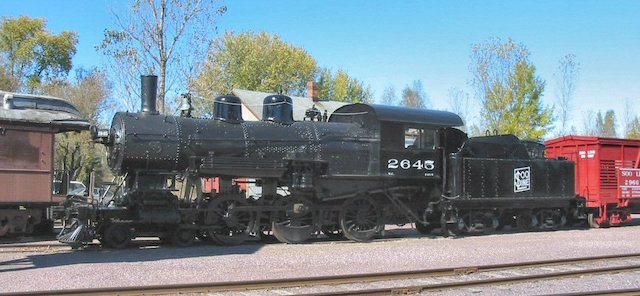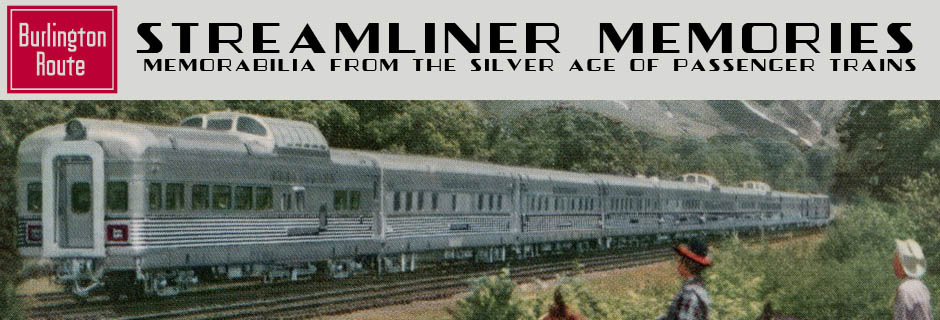Before 1900, the average passenger train in America consisted of four wooden cars weighing a total of about 160 tons. By 1930, the average passenger train had eight steel cars weighing a total of 450 tons. The all-steel revolution clearly demanded much more powerful locomotives than were available in 1900.
 Built in 1875, Virginia & Truckee’s Inyo is a typical example of a 4-4-0 locomotive. Click any image on this page for a larger view. Photo by Sam Schrantz.
Built in 1875, Virginia & Truckee’s Inyo is a typical example of a 4-4-0 locomotive. Click any image on this page for a larger view. Photo by Sam Schrantz.
For most of the 19th century, the locomotives most commonly used to haul passenger trains in the United States had four leading wheels, four driving wheels, and no trailing wheels, making them a 4-4-0. This wheel configuration was so common in the United States that it became known as American type. One of the first 4-4-0s was built for the Beaver Meadow Railroad, a coal-hauling line in Pennsylvania that eventually became part of the Lehigh Valley.
Built in 1837, Beaver Meadow’s 4-4-0 had 44″ driving wheels, 90 pounds of boiler pressure, and pistons that were 12″ in diameter with an 18″ stroke. A common way of estimating the power of a locomotive is by calculating its tractive effort using the formula:
Tractive Effort = D2*S*P/W where
D = the diameter of the pistons in inches
S = the stroke in inches
P = the boiler pressure in pounds per square inch and
W = the diameter of the driving wheels in inches.
The inches cancel out leaving a number that nominally represents the number of pounds that the locomotive can pull. For the Beaver Meadow locomotive, the tractive effort was slightly more than 4,500 pounds. Of course, the trains it pulled weighed a lot more than 4,500 pounds, but it wasn’t trying to lift them vertically, only to pull them horizontally. A locomotive might need about 5 pounds of tractive effort to pull an already-moving ton on straight, level track. More was needed to start, accelerate, go up hills, or go on curved track.
While tractive effort is an imperfect measure of a locomotive’s power, the formula gives clues about how to increase power: use larger diameter pistons and/or ones with longer strokes, higher pressure boilers, and/or smaller drivers. The Virginia & Truckee locomotive pictured above, for example, has larger (16″x24″) pistons, but larger (57″) wheels and lower (75 psi) boiler pressure, so its tractive effort (6,870 pounds) is only a little higher than the Beaver Meadow locomotive that was built 38 years earlier.
Smaller driving wheels made freight locomotives more powerful, but for time-sensitive passenger trains smaller wheels were a non-starter. For various reasons, including the time it takes to exhaust steam from a cylinder, smaller wheels meant slower trains. In general, steam locomotives could comfortably cruise about ten miles per hour faster than the driver diameter in inches, and probably were physically unable to go any more than about 60 or 70 percent faster than the driver diameters.
That meant that increasing power required larger pistons or higher boiler pressures. Doing either meant that the locomotive would have to generate more steam. The basic flaw in the 4-4-0 design was that the firebox, whose weight was supported by the drivers, had to fit between those drivers, which meant it could be no more than about three feet wide on a standard-gauge locomotive. The most powerful 4-4-0 locomotives built couldn’t boil enough water to sustain more than about 20,000 pounds of tractive effort.
Some of the last 4-4-0 locomotives built for a standard-gauge American railroad were constructed by Baldwin in 1901 for an Iowa short line called the Davenport, Rock Island and North Western Railway. With tender, they weighed 176,000 pounds, had 1,623 square feet of evaporative heating area, and produced about 17,500 pounds of tractive effort. More than 25,000 American type locomotives were built for U.S. railroads, so they clearly worked in the 19th century.
 Known as a “camelback,” this ungainly locomotive was designed with a wide firebox above the driving wheels. But this put the engineer and fireman in separate parts of the locomotive, eliminating their ability to communicate with one another.
Known as a “camelback,” this ungainly locomotive was designed with a wide firebox above the driving wheels. But this put the engineer and fireman in separate parts of the locomotive, eliminating their ability to communicate with one another.
One way to get more power was to use smaller wheels and put a full-width firebox above the wheels. Some locomotives like this were built in the 1870s, but they were unwieldy and the small driving wheels meant they could not reach the speeds demanded by passengers.
 This 4-6-0, or Mogul, locomotive was built in 1900 and produced about 31,000 pounds of tractive effort. Note that, even though the driving wheels are small, they are still large enough to crimp the size of the firebox. Photo by Sean Lamb.
This 4-6-0, or Mogul, locomotive was built in 1900 and produced about 31,000 pounds of tractive effort. Note that, even though the driving wheels are small, they are still large enough to crimp the size of the firebox. Photo by Sean Lamb.
Another popular locomotive in the late 19th century was the 4-6-0, which could be heavier than a 4-4-0 but still had the problem that the firebox supported by driving wheels big enough to reach passenger-train speeds had to be narrow. The most powerful 4-6-0s built around the turn of the century could produce about 35,000 pounds of tractive effort. About 17,000 4-6-0s were built for U.S. railroads, but they were inadequate for the heavier passenger trains of the early 1900s.
The other solution was to mount a full-width firebox behind the driving wheels. Due to the weight of the firebox, that necessarily required the addition of a two- or more-wheel trailing truck. In 1894, Baldwin Locomotive Company built a 4-4-2 for the Atlantic Coast Line, and since then this locomotive type has been called an Atlantic.
About 2,000 Atlantics were built, but this type had limited advantages over the American. For one thing, adding more power to a locomotive with four driving wheels, each of which had a contact area with the rails not much bigger than the size of a dime, meant that wheel slip would be a serious problem.
As a rule of thumb, minimizing wheel slip required that the weight on the drivers be more than four times tractive effort, so a locomotive with 30,000 pounds of tractive effort had to have at least 120,000 pounds on the drivers. Another rule of thumb was that the weight per axle on the rails used around 1900 (which typically weighed about 90 to 100 pounds per yard) couldn’t be more than about 30,000 to 40,000 pounds. Until heavier rail was in place — some railroads started installing rail weighing 130 pounds per yard or more in the 1920s — this severely limit the tractive effort of a locomotive with only two axles of drivers.
Important U.S. Locomotive Types
| Type | Number Built | First Built | Railroad |
|---|---|---|---|
| 4–4–0 | >25,000 | 1837 | Beaver Meadow |
| 4–6–0 | >17,000 | 1847 | Reading |
| 2–8–0 | >33,000 | 1866 | Lehigh Valley |
| 4–4–2 | 2,000 | 1894 | Atlantic Coast Line |
| 2–6–2 | 1,700 | 1898 | McCloud River |
| 4–6–2 | 6,800 | 1902 | Missouri Pacific |
| 2–10–2 | 2,200 | 1902 | Santa Fe |
| 2–8–2 | >14,000 | 1903 | Lehigh Valley |
| 2–8–8–2 | 700 | 1909 | Southern Pacific |
| 4–8–2 | 2,200 | 1911 | Chesapeake & Ohio |
| 2–8–4 | 750 | 1925 | Boston & Albany |
| 4-8-4 | 1,100 | 1926 | Northern Pacific |
| 4–6–4 | 500 | 1927 | New York Central |
| 2–8–8–4 | 200 | 1928 | Northern Pacific |
| 4–6–6–4 | 200 | 1936 | Union Pacific |
| 4–8–8–4 | 25 | 1941 | Union Pacific |
This list does not include all locomotive types, but only the most common types built for passenger service and a few well-known types for freight service. Sources: Alfred Bruce, The Steam Locomotive in America and SteamLocomotive.com.
Ironically, some of the fastest steam locomotives ever built were 4-4-2s. According to Alfred Bruce, who helped design the Milwaukee Hiawatha Atlantics in the early 1930s, in speed tests “the hand of the speed indicator was often reported against the pin at 128 miles per hour. Exactly what the maximum speed was reached is not now known — but it was plenty!”
Those locomotives had boiler pressures of 300 psi, which wasn’t achievable in 1900. Wheel slip was handled by putting more weight on the drivers: more than 70,000 pounds per driving axle, about twice as much as locomotives in 1900 and more than almost any rails could handle at that time. Given lighter weight rail, the only way to gain more traction was to have more driving wheels.
Clearly, something bigger than a 4-4-2 was needed in 1900. The first three decades of the 20th century would see a remarkable series of innovations that would virtually quadruple the size and power of American steam locomotives. I’ll describe those tomorrow.
